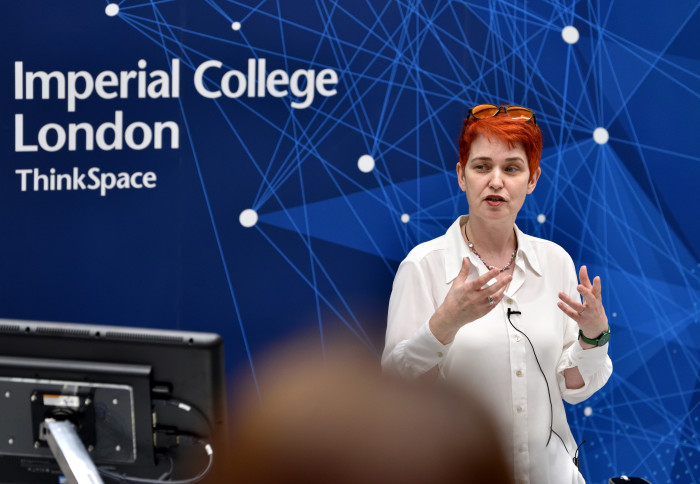White City Innovation District celebrates inaugural Life Sciences Summit

Imperial's Vice Provost (Research and Enterprise) Professor Mary Ryan delivers the opening keynote address at the Jawdrop Summit
Leading academics, innovative scaleups and established corporate players explore the future of the UK’s life sciences sector at the Jawdrop Summit.
The inaugural Jawdrop Summit, which took place at Imperial’s White City Campus, brought together academics, startups, scaleups, enterprise and investors to discuss the future of the UK’s life sciences sector. Welcoming the attendees, Vice Provost (Research and Enterprise) Professor Mary Ryan highlighted the success of Imperial’s partnership with the London Borough of Hammersmith and Fulham (LBHF) which led to the creation of the Deep Tech Network (DTN) – one of many key initiatives between Imperial and LBHF.
The Deep Tech Network, set up in 2019, supports a deep tech science innovation ecosystem at White City through connecting local start-ups and businesses and Imperial’s academic experts. The DTN's Jawdrop Summit included three panel discussions which explored the practical pathways to bring more collaboration, innovation and growth in the life sciences sector at pace.

Jawdrop Summit panel highlights
The panels began with an in-depth discussion examining the success of collaboration within White City, and how this can be hardwired into the life sciences community. Leader of the London Borough of Hammersmith and Fulham Council, Councillor Stephen Cowan explained how collaboration is a bedrock of the White City Innovation District, and pointed towards its recent partnership with Barcelona’s Innovation District as an example of the area’s networks growing on a global scale.
The second panel looked at the implications that AI has not only on life sciences but also the wider impact on society. Professor Aldo Faisal, from Imperial’s Departments of Bioengineering and Computing, pointed out the positive impact that AI will have on improving health outcomes in the future.
The final panel was made up of investors based in White City who discussed funding for the life sciences and how to secure the investments that will move innovations from the lab onto the market. Executive Editor of FirstWord HealthTech, Tina Tan chaired the session of expert panellists who all agreed that the UK’s reputation as a cluster for globally competitive life science innovation is drawing investment – their advice to companies was to get clear on exactly how their technology will create value for society, and the investment will follow.

Life Sciences and Deep Tech at Imperial
Imperial recently announced the launch of The Institute for Deep Tech Entrepreneurship. The Institute aims to drive the development of ground-breaking, ambitious technologies with world-changing potential, and help them find a pathway to market, addressing global challenges in areas such as climate change, improving human health and well-being, and developing sustainable food and water systems.
The Imperial-X (I-X) initiative is the College's flagship new interdisciplinary AI initiative driving AI research and its applications in diverse sectors from life sciences to space and defence. The I-X initiative will launch on 21 February.
White City Innovation District and Life Sciences

Imperial’s White City Campus anchors the White City Innovation District – a new innovation district and hub for our thriving life sciences community and an emergent economic and cultural hotspot in West London. At White City, Imperial is bringing academia and business together on an unprecedented scale to support economic growth and local skills, enterprise and innovation with an impact locally and across the UK.
Launched in May 2019, the Deep Tech Network is organised between Upstream, a partnership between the London Borough of Hammersmith and Fulham and Imperial, and Imperial’s Department of Chemistry and Enterprise Division. The DTN encourages collaboration between business and Imperial’s researchers to develop a deep-tech innovation ecosystem around Imperial’s White City Campus. You can keep up to date with the Deep Tech Network by signing up to their newsletter here.
Article text (excluding photos or graphics) © Imperial College London.
Photos and graphics subject to third party copyright used with permission or © Imperial College London.
Reporter
Nazza Ahmed
Office of the President
Rosie Skilbeck
College Headquarters